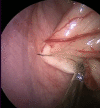Suspension sutures facilitate single-incision laparoscopic-assisted rectal pull-through for Hirschsprung disease
- PMID: 34059040
- PMCID: PMC8166018
- DOI: 10.1186/s12893-021-01260-w
Suspension sutures facilitate single-incision laparoscopic-assisted rectal pull-through for Hirschsprung disease
Abstract
Background: To present a surgical technique of single-incision laparoscopic-assisted endorectal pull-through (SILEP) with suspension sutures using conventional instruments for Hirschsprung disease (HD) and its long-term follow-up outcomes.
Methods: The procedure began with a 1 cm transumbilical skin incision. Three separate punctures were made in the fascia with a 5 mm scope in the middle and 5 mm and 3 mm ports for working instruments on the left and right, respectively. The first suspension suture was placed to secure the sigmoid colon to the abdominal wall. A window was created through the rectal mesentery, and dissection around the rectum was carried out. The second suspension suture was performed to suspend the rectovesical peritoneal fold or the rectovaginal peritoneal fold to the abdominal wall. Dissection around the rectum was continued downward to approximately 1 cm below the peritoneal fold. Then, the operation was completed by a transanal approach.
Results: Forty patients underwent SILEP from March 2013 to April 2015. The median age was 2.7 months (ranging from 1 to 17 months). The mean operative time was 96 ± 23 min. No conversion to an open operation was required. The average hospitalization time was 4.5 ± 2 days. There were no intraoperative or perioperative complications. Long-term follow-up results were obtained from 38 patients. A frequency of defecation from every other day to twice a day was noted for 33 patients (86.8%) and more often for 5 patients (13.2%). Two patients had enterocolitis (5.2%).
Conclusion: Single-incision laparoscopic rectal pull-through with suspension sutures using conventional instruments is feasible and safe for HD with good long-term outcomes.
Keywords: Hirschsprung disease; Laparoscopic; Rectal pull-through; Single incision; Suspension sutures.
Conflict of interest statement
The authors declare that they have no competing interests.
Figures
Similar articles
-
Hybrid Single-Incision Laparoscopic Approaches for Endorectal Pull-Through in Hirschsprung's Disease.J Laparoendosc Adv Surg Tech A. 2015 Jul;25(7):595-8. doi: 10.1089/lap.2014.0343. Epub 2015 Jan 16. J Laparoendosc Adv Surg Tech A. 2015. PMID: 25594866
-
Single-incision laparoscopic endorectal pull-through (SILEP) for hirschsprung disease.J Gastrointest Surg. 2010 Dec;14(12):1950-4. doi: 10.1007/s11605-010-1299-3. Epub 2010 Aug 18. J Gastrointest Surg. 2010. PMID: 20717739
-
Single-incision laparoscopic versus conventional laparoscopic endorectal pull-through for Hirschsprung's disease: a comparison of short-term surgical results.J Pediatr Surg. 2013 Sep;48(9):1919-23. doi: 10.1016/j.jpedsurg.2012.11.044. J Pediatr Surg. 2013. PMID: 24074668 Clinical Trial.
-
Laparoscopic-assisted approaches for the definitive surgery for Hirschsprung's disease.Semin Pediatr Surg. 2004 Nov;13(4):256-62. doi: 10.1053/j.sempedsurg.2004.10.013. Semin Pediatr Surg. 2004. PMID: 15660319 Review.
-
Primary laparoscopic endorectal pull-through for Hirschsprung's disease in infants and children.Semin Laparosc Surg. 1998 Mar;5(1):9-13. doi: 10.1177/155335069800500103. Semin Laparosc Surg. 1998. PMID: 9516554 Review.
Cited by
-
Transanal Endoscopic-Assisted Pull-Through Colectomy for Children with High Intestinal Aganglionosis.Children (Basel). 2022 Apr 21;9(5):588. doi: 10.3390/children9050588. Children (Basel). 2022. PMID: 35626766 Free PMC article.
-
Evidence-based advances in minimally invasive surgery in infants with congenital gastrointestinal anomalies: a narrative review.Transl Pediatr. 2024 May 31;13(5):791-802. doi: 10.21037/tp-23-611. Epub 2024 May 20. Transl Pediatr. 2024. PMID: 38840689 Free PMC article. Review.
References
MeSH terms
LinkOut - more resources
Full Text Sources
Medical
Miscellaneous




